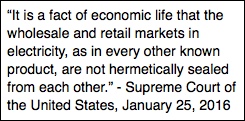What’s Wholesale and What’s Retail: DR, DER and SCOTUS
Depending on where you sit – a demand response provider or independent power producer – January 25, 2016 was either a good or a bad power day. That was the day that the Supreme Court of the United States (SCOTUS) upheld FERC order 745, allowing FERC and thereby, wholesale markets to have jurisdiction over demand response (DR). The ruling has settled DR jurisdiction; however, so much more is not settled when it comes to the bigger picture of distributed energy resources (DER).
The issue before the court was whether FERC has jurisdiction over DR compared to the states. It upheld FERC’s right make rules for the wholesale market – ISOs like PJM have been allowing demand response to bid into the market as generation for years. The more controversial decision was support of FERC its right to decide that DR could be paid at the locational marginal price (LMP) paid to traditional generation resource even though “retail” demand response resources also receive savings and/or incentives for participating DR programs from their local utility (LMP-G). The court did not want to decide for FERC, but rather posited that FERC was in the best position to make rules for the wholesale market. For an excellent in-depth review of demand response issues, I recommend reading The Evolution of Demand Response: the Road Ahead, a collaborative effort of stakeholders called the EDP.
 The Supreme Court addressed the wholesale market, leaving ambiguity about the rules of the retail market. With more DER (distributed generation, storage/electric vehicles, micro-grids, DR) coming onto the grid, expectations are that retail markets will be created. That is, in part, because, depending on its location on the grid, the value of the DER may be different. If there are capacity constraints to delivery power to the location and time of the demand, then the distributed resources have a greater value than in a situation where there is overcapacity in that location and time.
The Supreme Court addressed the wholesale market, leaving ambiguity about the rules of the retail market. With more DER (distributed generation, storage/electric vehicles, micro-grids, DR) coming onto the grid, expectations are that retail markets will be created. That is, in part, because, depending on its location on the grid, the value of the DER may be different. If there are capacity constraints to delivery power to the location and time of the demand, then the distributed resources have a greater value than in a situation where there is overcapacity in that location and time.
The wholesale markets were not built in a day, and with the addition of more dynamic and intermittent resources to the grid, it is likely that the development of distribution markets will take even longer to agree on. There are so many questions – where are the pricing nodes, what are the boundaries of the market, who are qualified market participants, what entities will operate the distribution grid, etc. Add to that the need for “real-time” operational infrastructure or “transactive energy systems” that NIST and the Pacific Northwest National Laboratory are defining. Those who recall the cost of establishing the wholesale markets in the 90s – in the hundreds of millions of dollars – know that there will need to be a great deal of effort required.
There are few that are tackling these issues in a comprehensive way. The New York Reforming Energy Vision (REV) is taking on the retail markets. The California ISO is tackling rules for the wholesale market through the Energy Storage and Distributed Energy Resources (ESDER) proceedings. No one is anticipating that central station generation will go away completely, but there will come a point where consumer demand for more choices and the need for the underlying network to support a more dynamic and distributed grid will force the issue. It is up to all the stakeholders to come together to build retail and wholesale markets that transparent and work in concert.
Comments are currently closed.